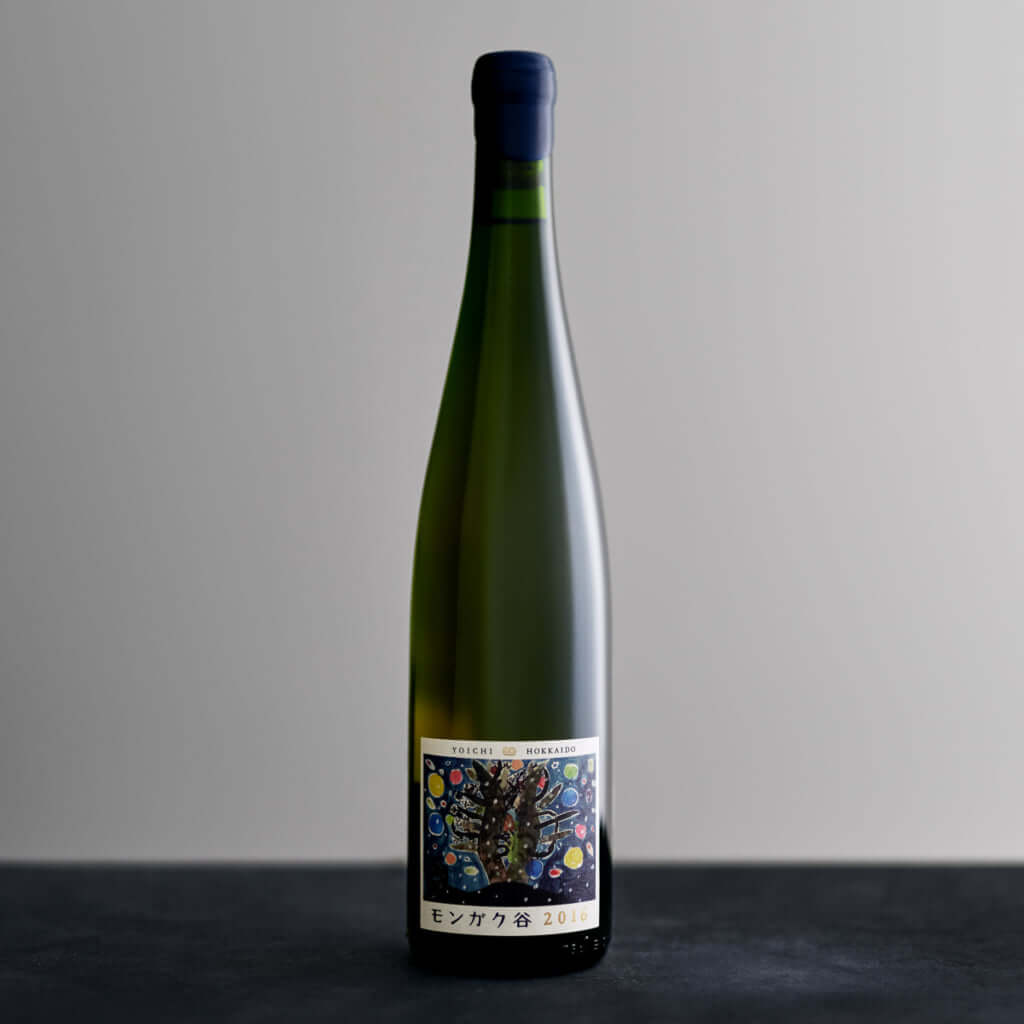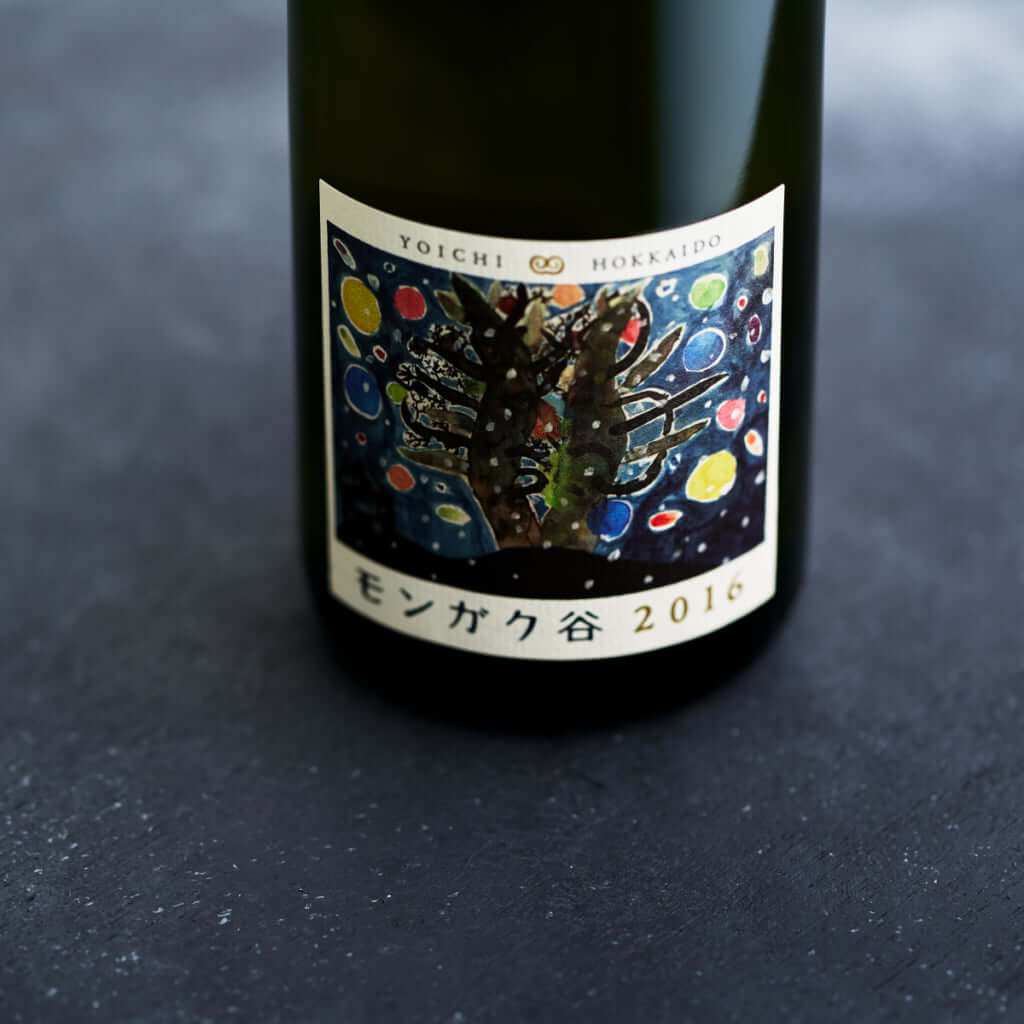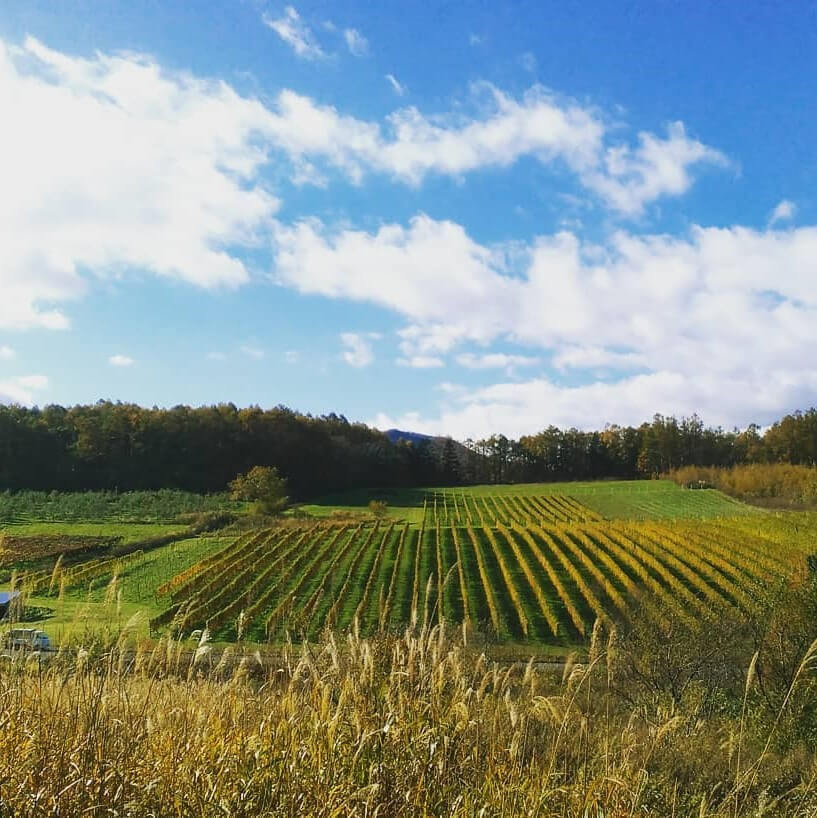Inspired by Blended Soup Stock, Vintners Create a White with Rich Volume
Mongaku Valley

In Hokkaido’s Yoichi-cho is an estate called Mongaku Valley. The top of the continuously gentle northern slope of the hill gives a spectacular view of Yoichi Bay and Cape Shiripa, a symbol of the town. On this land Shigeaki Kihara and his wife Yuko cultivate grapes and make them into wine.
Having a vision for making delicious wines through blending grapes harvested from their own vineyard, the Kiharas have determined which varieties to plant and the proportions of each. They have succeeded in designing the final taste of the wine entirely from varieties they have grown themselves.
Even though they wanted to make white wines, Pinot Noir, a dark purple grape, gives the flavor its base note. Other varieties were selected from the Pinot family—Pinot Gris, Pinot Blanc, and Chardonnay (which is a variety of Pinot Noir). In order to give a faintly bitter taste, they added Sauvignon Blanc.
‘We took a hint from the practice in Japanese cuisine of making a mixed soup stock by combining stock derived from skipjack tuna with stock derived from kelp’, relates Kihara. ‘But should we even emulate the animal-vegetable mixing of tuna with kelp? Whether we could create a pleasing balance by combining incompatible wines, we had no idea; so in principle we select varieties that are related to each other’.
All of the harvested grapes are pressed in a batch, as gently as possible, with the skins still on, and the juice is allowed to stand. The clear upper layer of liquid is drawn off, and vinification is started by the wild yeast fermenting a blended batch of grapes. Every effort is made to keep the grapes clean to promote orderly fermentation by wild yeast, but in some years a starter batch of yeast acting on a small amount of grapes is used.
The result is ‘Mongaku Valley’. Perhaps due to the large component of Pinot Noir, which is a dark grape, the color is rather deep for a white wine. Holding a sip in the mouth, the first sensation is one of volume, as we might have guessed from the coloration. The fruity flavor is soon followed by a pleasantly sour taste, with a lingering echo. While clearly a white wine, unlike wines made from a single variety, this has complexity.
With a crisp aftertaste that lingers in the heart, this wine is as though the beautiful nature of Mongaku Valley has been sublimated into wine.


Mongaku Winery
Area under direct cultivation: about 2 ha
Name of fermenter: Shigeaki and Yuko Kihara
Varieties and origin: Pinot Noir, Pinot Gris, Pinot Blanc, Chardonnay, Sauvignon Blanc, and others (Yoichi-cho, Shiribeshi region, Hokkaido)
Volume: 750 ml
Price: ¥5,000 (including tax)
Vinification: Must obtained by pressing clusters of grapes allowed to sit in a tank, the clear upper layer is then drawn off and wild yeast is relied on for fermentation. Small amounts of sulfite (potassium metabisulfite) are added a maximum of three times, during juicing, blending, and immediately before bottling (in the 2017 vintage, it was only added once, during blending). No added sugars, acid, or fining agent, and no filtering.
Viticulture: Low investment, low environmental burden, non-tillage, cover-cropped cultivation. Pesticides since the third year have been based on certified organic products (Bordeaux mixture, Bacillus cereus-based) and the like, in principle applied once a year. Including manually prepared liquid manure, leaves are sprayed several times per season. Fertilizer is prepared at the vineyard from cow manure, urchin shells, and other materials.
mongakuwinery.comNOTE: The 'Natural Wines' series introduces naturalist wines and natural wines produced as naturally as possible over all stages from grape cultivation to fermentation. What exactly does 'as naturally as possible' mean? In this series, it means 'minimal human intervention' during the secondary fermentation process. It also means 'no addition of sulfites during primary fermentation and bottling', or perhaps 'sulfites limited to an absolute minimum amount', and 'depending on natural yeast, without using cultured yeast, without additives'. Other expectations include 'No sugars are added, no adjustment with acids, no finishing agents, and generally no filtration'. In terms of grape cultivation, the basic premise is to avoid using synthetic agricultural chemicals, but growing wine varietals in the Japanese climate by organic methods is extremely problematic at present, so keeping the use of agricultural chemicals to a bare minimum is a reasonable expectation. As a general rule, herbicides and chemical fertilizers should be completely avoided. To successfully make wine in this way, grapes must be kept robust, and conscientious oversight of the fermentation process is indispensable. The vintners who succeed in raising grapes as naturally as possible in respect of the terroir, and the wines that they produce, are the deserving subjects of this series.
TRENDING
-
A Rare Japanese Garden Hidden Within Honen-in Temple in Kyoto
Visible only twice a year, ‘Empty River’, designed by landscape architect Marc Peter Keane, evokes the carbon cycle.

-
Colour Photos of Yakuza Tattoos from the Meiji Period
19th-century photographs have captured the usually hidden tattoos that covered the bodies of the members of Japanese organised crime gangs.

-
Modernology, Kon Wajiro's Science of Everyday Observation
Makeup, beard shape, organisation of cupboards and meeting places: all of these details decipher 1920s Tokyoites.

-
Hitachi Park Offers a Colourful, Floral Breath of Air All Year Round
Only two hours from Tokyo, this park with thousands of flowers is worth visiting several times a year to appreciate all its different types.

-
Yoshitomo Nara: What Lies Behind Insouciance and Appearances
Yoshitomo Nara's little girls with big eyes unsettle the viewer with the violence they exude and force them to discern the imperceptible.





